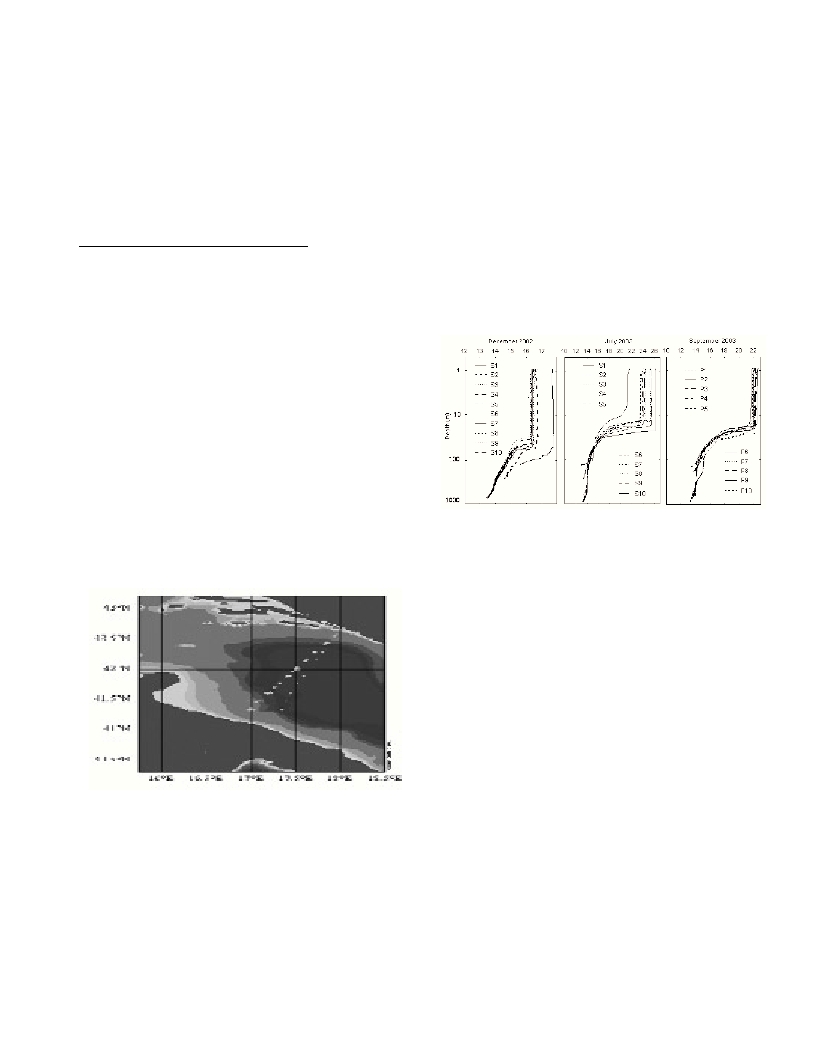Rapp. Comm. int. Mer Médit., 37,2004
126
XBT MEASUREMENTS IN THE DUBROVNIK-BARI TRANSECT - VOS2 ADRICOSM EXPERIMENT
Morovic Mira
1
*, Vlado Dadic
1
, Frano Matic
1
, Giuseppe Manzella
2
,
Branka Grbec
1
, Franco Reseghetti
2
, Damir Ivankovic
1
1
Institute of Oceanography and Fisheries, Šetalište Ivana Meštrovica 63, P.O.Box 500, 21000 Split, Croatia - * morovic@izor.hr
2
Ente per le Nuove tecnologie, l’Energia e il’Ambiente, Centro Ricerce Ambiente Marino, Pozzuolo Di Lerici, P.O. Box 224,
19100 La Spezia, Italy
Abstract
The temperature data from recent XBT measurements were acquired during the October 2002 to September 2003 period, at the two
transects, one across and the other along the Adriatic, during the first year of the ADRICOSM experiment. Through the data analysis,
different phenomena were observed. The data from Dubrovnik-Bari transect were analysed, with a reference to the other measurements in
the area.
Keywords: Adriatic Sea, temperature, salinity
Introduction
Thermohaline conditions of the South Adriatic behave in a slightly
different way from East to the West coast. Intermediate layers of the
South Adriatic are in?uenced by in?ows of more saline (>38.7 PSU)
(1, 2), and nutrient richer LIW water from the Mediterranean, while
bottom layers of the West coast are under the in?uence of the
NAdDW. The intrusions of LIW bring warmer water into the Adriatic
(3), while those at the West coast bring less saline and colder waters.
The LIW intrusions are stronger in the winter period especially when
driven by the strong atmospheric pressure ?uctuations (4) over the
area wider than Mediterranean, however the condition for formation
of NAdDW and stronger LIW intrusions seems to coincide, since both
occur during cold winters.
The VOS2 ADRICOSM experiment performed in the Southern
Adriatic enabled following a number of phenomena in a near real
time. Combining these data with the other sea truth data acquired in
the same area and time, and meteorological data, we were able to get
better explanation about these phenomena.
Materials
Starting from October 2002, fourtheen VOS XBT measurements
(10 stations) were performed within a year period: monthly in the cold
season and with almost fouthnight frequency in warm season.
Transect between Dubrovnik and Bari was survayed underway regular
ferry connection. The ferryboat almost repeated the route (Fig. 1).
Fig. 1. Position of measuring stations with GPS, installed onboard the
ship. During most of the VOS measurements, transects were very close,
except in December 2002, when the ships’ route deviated from usual.
Preliminary results
In the eastern side of the Adriatic temperature was higher in the
whole water column most of the year, except in July, when the first
meters of water were warmer in Italian side. The difference of almost
2şC between the surface temperature of the two sides was observed in
December (Fig. 2). The temperature difference in deeper layers
between the two sides may indicate intrusions of warmer LIW
towards the Eastern coast.
The summer 2003 was dry and with moderate winds; especially the
ethesian wind Maestral was not strong and frequent as usually. This
resulted in a shallow thermocline ill the end of July. Only in
September, after episodes of strong winds thermocline reached 30m.
Reference is also given to the measurements of the other VOS1
ADRICOSM group (OGS, Trieste), from Susac-Brindisi transect, that
brought information about the longitudinal movements in the
Southern Adriatic.
Fig. 2. Vertical temperature profile in the stations nearest to Dubrovnik
and Bari, and the station in the middle of the transect.
The comparison was done between XTB data and CTD
measurements acquired during the summer cruise of the international
project Meduza (www.izor.hr/Meduza/index.htm) and the data
measured through 2002-2003 period, in the frame of Jadran project
(Croatian National Monitoring Program), both in close locations and
times to XBT stations. From these data we tried to control salinity
calculated from the sound velocity and temperature.
The measurements from the Southern Adriatic were supported with
ECMWF reanalysis data for the region.
Through the ADRICOSM VOS2 experiment we were able to
observe, in a near real time, a number of phenomena like evolution
and breakdown of seasonal thermocline, effect of turbulent mixing
due to the action of wind, spreading of the cold water vein along the
Italian coast, intrusions of warmer LIW towards the Eastern coasts
etc.
The contents of this article were developed under a financial
support from the Istituto Nazionale di Geofisica e Vulcanologia, Italy,
and funded under Italian Ministry for the Environmentcontract
ADRICOSM
References
1-Zore-Armanda, M., 1969. Water exchange between the Adriatic and
the Eastern Mediterranean. Deep-Sea Research, 16: 171178.
2-Buljan, M. & M. Zore-Armanda, 1976. Oceanographical properties of
the Adriatic sea.-oceanogr. Mar. Biol. Ann. Rev., 14: 11-98.
3-Zore-Armanda, M., 1971. In?uence of the long term changes in
oceanographic /meteorological conditions in the North Atlantic on the
Mediterranean. The ocean World, Proc. Joint Oceanogr. Assembly, Tokyo
1970, pp. 151-154.
4-Grbec, M., Morovic and M. Zore-Armanda, 2003. Mediterranean
Oscillation Index and its relationship to inerannual salinity ?uctuations
in the Adriatic Sea, Acta Adriatica, 44(1): 61-76.

